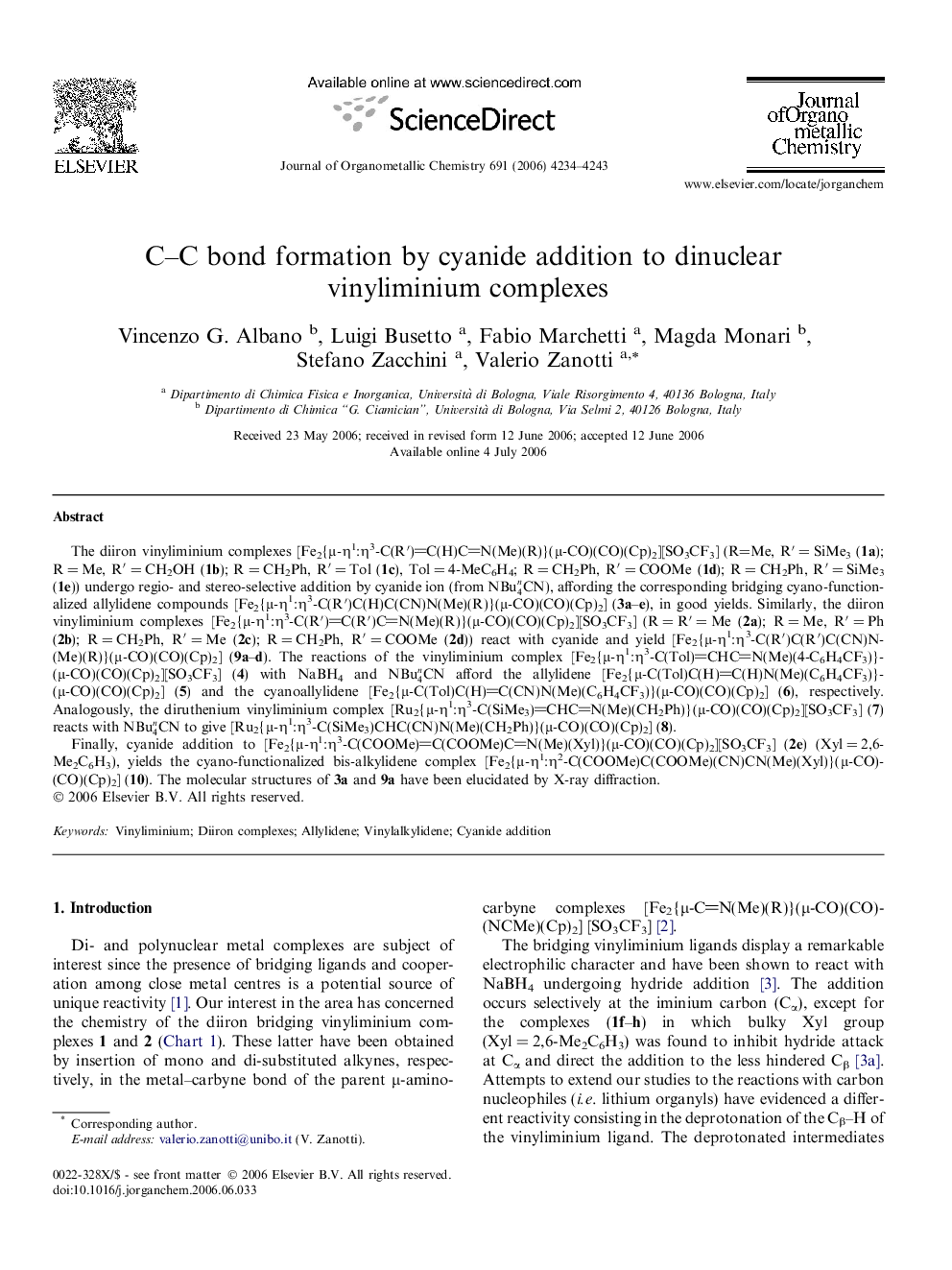| کد مقاله | کد نشریه | سال انتشار | مقاله انگلیسی | نسخه تمام متن |
|---|---|---|---|---|
| 1328481 | 977579 | 2006 | 10 صفحه PDF | دانلود رایگان |

The diiron vinyliminium complexes [Fe2{μ-η1:η3-C(R′)C(H)CN(Me)(R)}(μ-CO)(CO)(Cp)2][SO3CF3] (R=Me, R′ = SiMe3 (1a); R = Me, R′ = CH2OH (1b); R = CH2Ph, R′ = Tol (1c), Tol = 4-MeC6H4; R = CH2Ph, R′ = COOMe (1d); R = CH2Ph, R′ = SiMe3 (1e)) undergo regio- and stereo-selective addition by cyanide ion (from NBu4nCN), affording the corresponding bridging cyano-functionalized allylidene compounds [Fe2{μ-η1:η3-C(R′)C(H)C(CN)N(Me)(R)}(μ-CO)(CO)(Cp)2] (3a–e), in good yields. Similarly, the diiron vinyliminium complexes [Fe2{μ-η1:η3-C(R′)C(R′)CN(Me)(R)}(μ-CO)(CO)(Cp)2][SO3CF3] (R = R′ = Me (2a); R = Me, R′ = Ph (2b); R = CH2Ph, R′ = Me (2c); R = CH2Ph, R′ = COOMe (2d)) react with cyanide and yield [Fe2{μ-η1:η3-C(R′)C(R′)C(CN)N(Me)(R)}(μ-CO)(CO)(Cp)2] (9a–d). The reactions of the vinyliminium complex [Fe2{μ-η1:η3-C(Tol)CHCN(Me)(4-C6H4CF3)}(μ-CO)(CO)(Cp)2][SO3CF3] (4) with NaBH4 and NBu4nCN afford the allylidene [Fe2{μ-C(Tol)C(H)C(H)N(Me)(C6H4CF3)}(μ-CO)(CO)(Cp)2] (5) and the cyanoallylidene [Fe2{μ-C(Tol)C(H)C(CN)N(Me)(C6H4CF3)}(μ-CO)(CO)(Cp)2] (6), respectively. Analogously, the diruthenium vinyliminium complex [Ru2{μ-η1:η3-C(SiMe3)CHCN(Me)(CH2Ph)}(μ-CO)(CO)(Cp)2][SO3CF3] (7) reacts with NBu4nCN to give [Ru2{μ-η1:η3-C(SiMe3)CHC(CN)N(Me)(CH2Ph)}(μ-CO)(CO)(Cp)2] (8).Finally, cyanide addition to [Fe2{μ-η1:η3-C(COOMe)C(COOMe)CN(Me)(Xyl)}(μ-CO)(CO)(Cp)2][SO3CF3] (2e) (Xyl = 2,6-Me2C6H3), yields the cyano-functionalized bis-alkylidene complex [Fe2{μ-η1:η2-C(COOMe)C(COOMe)(CN)CN(Me)(Xyl)}(μ-CO)(CO)(Cp)2] (10). The molecular structures of 3a and 9a have been elucidated by X-ray diffraction.
Cyanide anion gives regio- and stereo-specific addition at the Cα of the μ-vinyliminium ligand, in dinuclear complexes, affording novel bridging cyano-functionalized allylidene complexes. The reaction is influenced by the nature of the R substituent: when R = Xyl, the addition to Cα is inhibited, or it occurs at the Cβ position.Figure optionsDownload as PowerPoint slide
Journal: Journal of Organometallic Chemistry - Volume 691, Issue 20, 1 October 2006, Pages 4234–4243